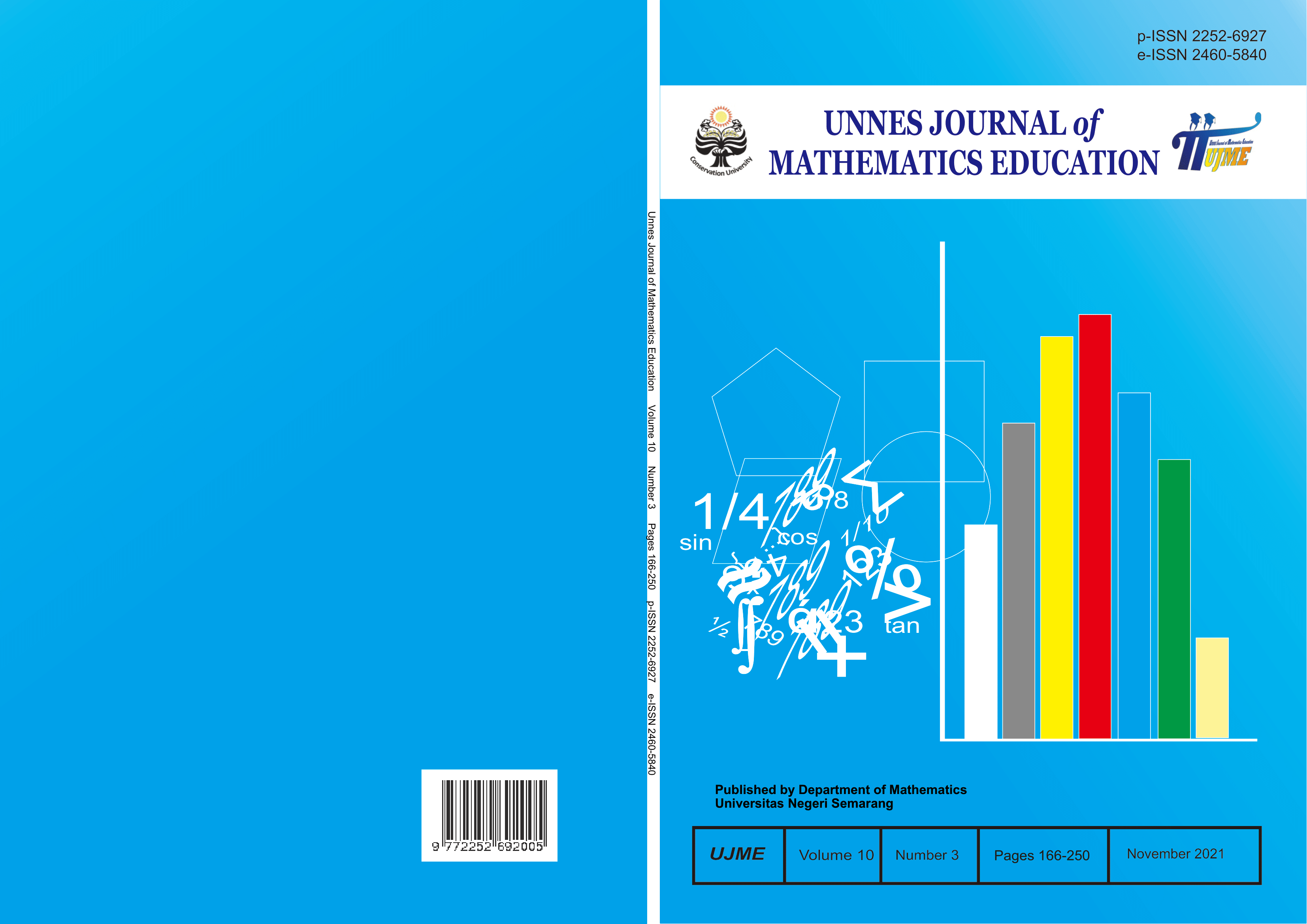The mathematical communication ability based on student's self-confidence in Problem Based Learning models with brainstorming techniques
##plugins.themes.academic_pro.article.main##
Abstract
The mathematical communication ability is an important aspect that every student must have. The Facts show that mathematical communication ability and student confidence are still not optimal. One effort to overcome that is by applying PBL models with brainstorming techniques. The purpose of this study was to test the effectiveness of the PBL model with brainstorming techniques on students' mathematical communication ability, describing mathematical communication ability on PBL models with brainstorming techniques in terms of student confidence. This research uses mix method approach with a concurrent embededded model. The population of this study was class VIII of SMP Negeri 1 Ungaran in the 2018/2019 school year. The results showed that: PBL models with effective brainstorming techniques for learning as indicated by learning outcomes in aspects of mathematical communication ability achieve mastery learning individually and classically as well as the average learning outcomes in classes using PBL models with brainstorming techniques more than average learning outcomes in the classroom using the PBL model, subjects with high self-esteem can meet all indicators of mathematical communication ability, on subjects with moderate self-confidence only able to meet indicators explaining ideas, situation and mathematical relationship at writing and indicators listening, discussing and writing about mathematics. Whereas for subjects with low levels of self confidence have not been able to meet all indicators of students' mathematical communication ability.
##plugins.themes.academic_pro.article.details##
References
Arifin, A. T., Kartono, & Sutarto H. (2014). Keefektifan Strategi Pembelajaran React pada Kemampuan Siswa Kelas VII Aspek Komunikasi Matematis. Jurnal Kreano. Jurusan Matematika FMIPA Universitas Negeri Semarang, 5(1).
Al-khatib, B. A. (2012). The effect of using brainstorming strategy in developing creative problem solving skills among female students in Princess Alia University College. American International Journal of Contemporary Research, 2(10): 29-38.
Ameliah, I. H., Munawaroh, M., & Muchyidin, A. (2016). Pengaruh Keingintahuan Dan Rasa Percaya Diri Siswa Terhadap Hasil Belajar Matematika Kelas VII Mts Negeri I Kota Cirebon. Eduma. 5(1).
Jahani, F. & Behzadi, M. H. (2014). Effect of Self-Believe of Students on Educational Progress of Mathematics. Jurnal Mathematics Education Trends and Research, 6 (2): 1-8.
Fachrurazi. (2011). Penerapan Pembelajaran Berbasis Masalah untuk Meningkatkan Kemampuan Berpikir Kritis dan Komunikasi Matematis Siswa Sekolah Dasar. Edisi Khusus No 1: 76-88.
Fathiya, R. (2014). Identifikasi Tahap Berpikir Kreatif Menggunakan Model PBL dengan Tugas Pengajuan Masalah. Unnes Journal of Mathematics Education. 3(1).
Hastuti, W. P. (2014). Peningkatan Kemampuan Komunikasi Matematika Melalui Strategi Problem Based Learning. Naskah Publikasi
Kemdikbud. (2014). Peraturan Menteri Pendidikan dan Kebudayaan Nomor 58 tahun 2014 tentang Kurikulum 2013 SMP/MTS. Jakarta: Depdiknas.
Melisa, H. (2015). Perbedaan Kepercayaan Diri dan Konsep Diri Pada Mahasiswa yang Mengalami Obesitas di Tinjau Dari Jenis Kelamin (Doctoral dissertation, Universitas Medan Area).
NCTM. (1989). Curriculum and Evaluation Standards for School Mathematics. Reston, VA: NCTM.
NCTM. (2000). Principles and Standards for School Mathematics. USA: NCTM.
Nurlia. (2015). Kemampuan Komunikasi Matematika dalam Pembelajaran Realistik. Jurnal Daya Matematis, 3(3): 328-336.
Sugiyono. (2016). Metode Penelitian Kombinasi (Mixed Methods). Bandung: Alfabeta Bandung.
Tandiling, E. (2012). Pengembangan Instrumen untuk Mengukur Kemampuan Komunikasi Matematik, Pemahaman Matematik, dan Self Regulated Learning Siswa dalam Pembelajaran Matematika di Sekolah Menengah Atas. Jurnal Penelitian Pendidikan, 13(1):24–35.
Wulandari, A. A. (2010). Efektifitas Penggunaan Metode Group Investigation Dan Brainstorming Terhadap Prestasi Belajar Matematika Siswa Kelas V Sekolah Dasar Negeri Se-Kecamatan Laweyan Pada Pokok Bahasan Sifat-Sifat Bangun Datar Ditinjau Dari Aktivitas Belajar Siswa. Tesis. Universitas Negeri Sebelas Maret.
